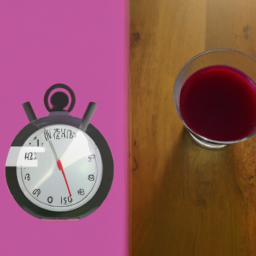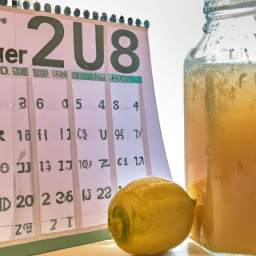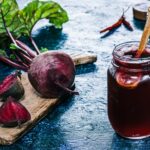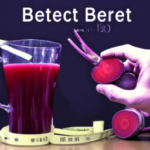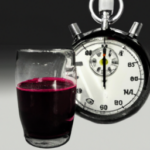I have been continuously searching for natural methods to enhance my skin’s appearance, and beetroot juice has caught my attention recently. Not only is it rich in vitamins and antioxidants, but it is also acclaimed for its skin-brightening properties.
But how much beetroot juice do you need to drink to see results?
In this article, I’ll dive into the science behind beetroot juice and skin whitening, how much you should drink, and how long it takes to see results. I’ll also share some tips on how to incorporate beetroot juice into your diet and other natural skin whitening solutions to try.
So let’s get started and see if beetroot juice is the answer to our skin woes.
The Science Behind Beetroot Juice and Skin Whitening
Want to know the secret behind using beetroot juice for skin whitening? Let’s dive into the science of it all!
Beetroot juice contains high levels of vitamin C, which is a powerful antioxidant that helps to fight free radicals and prevent skin damage. Additionally, beetroot juice is also rich in iron, which helps to oxygenate the skin and promote healthy blood circulation.
Moreover, the betalain pigments present in beetroot juice can reduce melanin production, which is responsible for skin pigmentation. This means that regular consumption of beetroot juice can gradually lighten the skin and reduce the appearance of dark spots and blemishes.
In addition to this, beetroot juice can also improve skin texture by increasing collagen production and promoting cellular regeneration. So, if you want to achieve brighter, clearer, and smoother skin, adding beetroot juice to your diet can be a great start!
Ready to start incorporating beetroot juice into your daily routine? But how much beetroot juice should you drink? Let’s find out in the next section.
How Much Beetroot Juice Should You Drink?
You’ll need to moderate your intake of beetroot juice to achieve the desired results for your skin. While drinking beetroot juice is an excellent way to improve your skin’s appearance, overconsumption can lead to adverse effects like diarrhea, stomach cramps, and low blood pressure. The recommended daily intake of beetroot juice for overall health is between 250-500ml. However, when it comes to using beetroot juice for skin whitening, it’s better to start with a smaller amount and gradually increase it.
To give you an idea of how much beetroot juice you’ll need to drink, here’s a table that shows the amount of beetroot juice needed to achieve different levels of skin whitening:
| Skin Whitening Level | Beetroot Juice Intake |
|---|---|
| Mild | 250ml/day |
| Moderate | 350ml/day |
| Significant | 500ml/day |
Remember that the amount of juice you need to drink will depend on your skin type, lifestyle, and overall health. It’s also essential to keep in mind that drinking beetroot juice alone won’t guarantee skin whitening. It’s best to combine it with a healthy diet, exercise, and proper skincare routine to achieve the best results. With that said, let’s move onto the next section, which will cover how to prepare beetroot juice.
Preparing Beetroot Juice
To start preparing your own beetroot juice for healthier skin, all you’ll need are fresh beetroots, a juicer, and a tall glass to pour your vibrant red juice.
Here are some steps to guide you in making your own beetroot juice:
- Wash the beetroots thoroughly to remove any dirt or debris.
- Cut the beetroots into small pieces to fit in the juicer.
- Juice the beetroots in the juicer until all the juice is extracted.
Aside from drinking beetroot juice alone, you can also mix it with other fruits and vegetables to create a tasty and nutritious beetroot smoothie recipe.
It’s also important to note that aside from its potential for skin whitening, beetroot juice has a lot of health benefits, such as reducing inflammation, improving digestion, and lowering blood pressure.
With that said, in the next section, we’ll discuss the best time to drink beetroot juice for maximum benefits.
Best Time to Drink Beetroot Juice
I often wonder when the best time to drink beetroot juice is for maximum benefits. After some research, I found that it’s best to drink beetroot juice on an empty stomach – either in the morning or at night.
Drinking it before meals can also help with digestion and absorption of nutrients.
Before or After Meals
If you’re looking to incorporate beetroot juice into your diet for skin whitening, consider drinking it either before or after meals. The timing for maximum effect will depend on your individual preferences and lifestyle. Here are five reasons to consider drinking beetroot juice before or after meals:
- Drinking beetroot juice before a meal can help increase your appetite and aid in digestion.
- Drinking beetroot juice after a meal can help regulate blood sugar levels and prevent spikes in insulin.
- Beetroot juice contains nitrates that can improve blood flow and reduce inflammation, making it a great pre-workout drink.
- Drinking beetroot juice after a workout can help your body recover faster and reduce muscle soreness.
- Beetroot juice is a low-calorie, nutrient-dense drink that can help you stay hydrated throughout the day.
When it comes to drinking beetroot juice for skin whitening, the timing is just one factor to consider. In the next section, we’ll discuss whether it’s best to drink beetroot juice in the morning or at night.
Morning or Night
Before or after meals, the timing of drinking beetroot juice has been a common question for those who want to achieve skin whitening. However, another important factor to consider is whether to consume it in the morning or at night.
When it comes to the morning vs. night debate, it is important to consider what works best for you personally. Drinking beetroot juice in the morning may help to jumpstart your metabolism and give you an energy boost for the day ahead. In contrast, drinking it at night may help you to relax and unwind after a long day, promoting better sleep. Ultimately, it is up to you to decide when to consume it. However, it is important to note that drinking beetroot juice daily may be more effective than consuming it weekly.
To further understand the benefits of drinking beetroot juice, here is a table that lists the nutrients found in a 100-gram serving of raw beetroot:
| Nutrient | Amount |
|---|---|
| Calories | 43 |
| Carbohydrates | 10 g |
| Fiber | 2 g |
| Protein | 1.6 g |
| Fat | 0.2 g |
| Vitamin C | 8% of the Daily Value (DV) |
| Folate | 20% of the DV |
| Potassium | 9% of the DV |
| Magnesium | 6% of the DV |
As shown in the table, beetroot is a good source of nutrients that can benefit your skin and overall health. Whether you choose to drink it in the morning or at night, consuming it daily may help to maximize its potential benefits. So, what about the results of drinking beetroot juice for skin whitening? Let’s explore that in the next section.
How Long to See Results
You may start seeing results within a week or two of drinking beetroot juice for skin whitening, but consistent consumption for at least a month is recommended for optimal benefits. The expected time for results may vary depending on factors such as skin type, diet, and lifestyle. However, research has shown that the high levels of antioxidants and vitamin C in beetroot juice can help reduce hyperpigmentation, lighten dark spots, and improve overall skin tone.
To maintain the benefits of beetroot juice for skin whitening, it’s important to incorporate it into your daily routine. Drinking a glass in the morning or at night can be a good way to start. It’s also important to note that while beetroot juice can help improve skin pigmentation, it’s not a substitute for sunscreen or a proper skincare routine.
With consistent consumption and proper skincare practices, you can expect to see a brighter and more even complexion over time.
Beetroot juice also offers other benefits, such as improving digestion and reducing inflammation in the body.
In the next section, we’ll explore these additional benefits of consuming this nutrient-packed juice.
Other Benefits of Beetroot Juice
I’ve been drinking beetroot juice for a while now, and I’ve noticed other benefits apart from its skin-whitening effects.
Firstly, it’s improved my digestion. I used to suffer from bloating and constipation, but since I started drinking beetroot juice, my digestive system has been functioning much better.
Secondly, my blood pressure has lowered, which is great news for my overall health.
Lastly, I’ve noticed an increase in my stamina, especially during workouts. This is because beetroot juice has been shown to improve oxygen delivery to the muscles, which reduces fatigue and improves endurance.
Improved Digestion
Daily consumption of beetroot juice can help improve digestion, leading to better absorption of nutrients. This is because beetroot juice contains dietary fiber, which promotes regular bowel movement and prevents constipation. Additionally, the betaine in beetroot juice stimulates the liver to produce more bile, which breaks down fats and aids in their absorption.
Benefits:
- Regular bowel movement
- Prevents constipation
Side Effects:
- May cause beeturia (pink or red urine)
- May interact with certain medications
Improving digestion is just one of the many benefits of drinking beetroot juice. In the next section, we’ll discuss how it can also help lower blood pressure.
Lower Blood Pressure
Lowering blood pressure can be achieved through regular consumption of beetroot juice due to its high nitrate content. Nitrate-rich foods like beets are converted into nitric oxide in the body, which helps to relax and dilate blood vessels. This, in turn, reduces the workload on the heart and lowers blood pressure. Studies have shown that drinking just one cup of beetroot juice daily can lower blood pressure within hours and sustain the effect for up to 24 hours.
Benefits of incorporating beetroot juice into your diet for blood pressure management are numerous. In addition to lowering blood pressure, beetroot juice is also a good source of potassium, which can further aid in regulating blood pressure. Tips for managing blood pressure through beetroot juice consumption include drinking one cup daily, and incorporating other nitrate-rich foods like leafy greens and celery into your diet. With these simple adjustments, you can reap the health benefits of beetroot juice and maintain a healthy blood pressure level.
Incorporating beetroot juice into your diet can also lead to increased stamina.
Increased Stamina
By incorporating beetroot juice into your diet, you’ll notice an increase in stamina due to its high nitrate content. Nitrate is converted to nitric oxide in the body, which helps to widen blood vessels and improve blood flow. This increased blood flow delivers more oxygen and nutrients to your muscles, which in turn helps to increase endurance and athletic performance.
To further emphasize the benefits of beetroot juice for increased stamina, here are a few key points to keep in mind:
- Studies have shown that consuming beetroot juice can lead to a significant improvement in time to exhaustion during exercise.
- The nitrate in beetroot juice has been shown to improve muscle efficiency, meaning that your muscles can do more work with less oxygen.
- Beetroot juice may also help to reduce the amount of oxygen needed during exercise, which can help to delay fatigue and improve endurance.
- The benefits of beetroot juice for increased stamina are not limited to athletes – anyone can benefit from improved endurance and energy levels.
Incorporating beetroot juice into your diet is easy and can be done in a variety of ways. Here are some simple tips:
- Add beetroot juice to your morning smoothie or juice.
- Mix beetroot juice with other juices or water to make a refreshing drink.
- Use beetroot juice as a base for salad dressings or marinades.
- Drink beetroot juice before or after exercise for maximum benefits.
By following these tips, you can easily incorporate beetroot juice into your daily routine and enjoy the benefits of increased stamina and endurance.
How to Incorporate Beetroot Juice into Your Diet
To add some color to your meals while also improving your skin, try incorporating beetroot juice into your diet. There are several ways to consume beetroot juice, such as making a beetroot smoothie or adding it to a beetroot salad. You can also drink it straight up or mix it with other juices for a more palatable taste.
If you’re new to drinking beetroot juice, start with a small amount and gradually increase your intake. It’s recommended to drink 8-16 ounces of beetroot juice per day to see its full potential benefits. However, be aware that beetroot juice may have some side effects, so it’s important to consult with your healthcare provider before incorporating it into your diet. Some people may experience changes in urine or stool color after drinking beetroot juice, but this is a harmless and common effect. Additionally, individuals with kidney problems should exercise caution due to the high oxalate content. It’s also useful to measure specific juice quantities when adding it to recipes, much like one might ask how much juice is in one lemon when following cooking instructions.
In the next section, we’ll discuss some precautions to take when drinking beetroot juice.
Precautions for Drinking Beetroot Juice
Before incorporating beetroot juice into your diet, it’s important to note that excessive intake can lead to a condition called beeturia, which affects approximately 10-14% of the population. This condition causes urine to turn pink or red, which can be alarming but is generally harmless. However, if you experience abdominal pain, nausea, or vomiting after drinking beetroot juice, it may be a sign of a more serious allergic reaction. In this case, it’s important to seek medical attention immediately.
Another precaution to keep in mind when drinking beetroot juice is its potential interactions with certain medications. Beetroot juice contains high levels of nitrates, which can lower blood pressure and interact with medications used to treat hypertension, such as ACE inhibitors or beta-blockers. It’s important to consult with your healthcare provider before incorporating beetroot juice into your diet if you’re taking any medications or have a history of low blood pressure.
When it comes to achieving brighter skin, beetroot juice is just one of many natural solutions to consider. In the next section, we’ll explore other options to help you achieve your desired results.
Other Natural Skin Whitening Solutions
I’ve always been interested in finding natural solutions for skin whitening. After trying out beetroot juice, I decided to explore other options.
Citrus fruits, turmeric, and aloe vera are all popular natural remedies for achieving lighter skin. Let’s take a closer look at these three options and their potential benefits.
Citrus Fruits
If you’re looking to brighten up your skin, adding some delicious citrus fruits to your diet might be just the thing. These fruits are loaded with vitamin C, which is a powerful antioxidant that helps to protect your skin from damage caused by free radicals.
Here are some reasons why citrus fruits should be a staple in your diet:
- They can help to even out your skin tone and reduce the appearance of dark spots.
- Citrus fruits can boost collagen production, which is essential for maintaining healthy, youthful-looking skin.
- They’re great juice pairings with other fruits and vegetables that also promote healthy skin.
- Citrus fruits can also have benefits for hair, helping to strengthen hair follicles and prevent hair loss.
So, if you’re looking to achieve a brighter, more radiant complexion, be sure to incorporate some citrus fruits into your daily diet. And if you’re interested in exploring other natural skin whitening solutions, keep reading to learn about the skin benefits of turmeric.
Turmeric
After learning about the skin benefits of citrus fruits, I’ve decided to try out a new ingredient for my skincare routine: turmeric.
Turmeric has been used for centuries in Ayurvedic medicine for its anti-inflammatory and antioxidant properties. In recent years, it has gained popularity in the skincare industry for its ability to brighten and even out skin tone.
One of the main benefits of turmeric for skin is its ability to reduce hyperpigmentation. The active ingredient in turmeric, curcumin, can inhibit the production of melanin, which is responsible for dark spots and uneven skin tone. Additionally, turmeric has antibacterial properties that can help prevent acne and improve overall skin health.
There are many ways to incorporate turmeric into your skincare routine, such as using it in a face mask or adding it to your daily moisturizer. There are also many turmeric recipes available online for those who want to make their own skincare products at home.
As I continue to explore natural ingredients for my skincare routine, I’m excited to see what benefits aloe vera can offer. With its hydrating properties and ability to soothe irritated skin, aloe vera has been a staple in many skincare products for years.
Aloe Vera
You may have heard of aloe vera and its amazing benefits for your skin. Aloe vera is a succulent plant that’s been used for centuries for its medicinal properties. It’s rich in vitamins, minerals, and antioxidants that can nourish and protect your skin.
Aloe vera is known for its ability to hydrate and soothe the skin, making it a popular ingredient in skincare products. It’s also effective in treating acne, sunburn, and other skin conditions.
In addition to its benefits for the skin, aloe vera is also great for hair growth. Aloe vera contains enzymes that can promote healthy hair growth and prevent hair loss. It can also help to balance the pH level of your scalp, which can prevent dandruff and other scalp conditions.
Aloe vera can be used as a natural hair conditioner, leaving your hair soft and shiny. To use aloe vera for hair growth, simply apply fresh aloe vera gel to your scalp and hair, leave it on for 30 minutes, and then rinse it off with water.
Frequently Asked Questions
Are there any side effects of drinking beetroot juice for skin whitening?
I have researched potential side effects of drinking beetroot juice for skin whitening. Long-term effects and contraindications with medication are important factors to consider. Evidence-based information is necessary to make informed decisions.
Can beetroot juice help with other skin concerns besides whitening?
Beetroot juice has potential anti-aging benefits due to its high antioxidant content. It also contains anti-inflammatory properties that may help with acne prevention. Compared to topical skin whitening products, drinking beetroot juice may have fewer side effects.
How does drinking beetroot juice compare to using topical skin whitening products?
Drinking vs Topical: Which is Better for Skin Whitening? Beetroot Juice vs Skin Lightening Creams: Pros and Cons. While beetroot juice has natural skin-lightening properties, topical creams may provide faster results. However, topical creams often contain harmful chemicals, while beetroot juice is a safer option.
Can drinking beetroot juice alone provide significant skin whitening results, or does it need to be combined with other lifestyle changes?
Drinking beetroot juice alone may not provide significant skin whitening results. However, incorporating it into a healthy lifestyle that includes a balanced diet, exercise, and adequate hydration can improve overall skin health and potentially enhance skin tone.
Is it safe to drink beetroot juice every day for an extended period of time?
Drinking beetroot juice daily has potential long-term effects such as lower blood pressure and improved athletic performance. However, it’s recommended to consume no more than 2 cups per day to avoid negative consequences like kidney damage.
Conclusion
Overall, drinking beetroot juice can have numerous benefits for both your overall health and your skin. While it may take some time to see noticeable results in terms of skin whitening, regular consumption of beetroot juice can improve your skin’s overall appearance and health.
As with any natural remedy, it’s important to exercise caution and ensure that you’re not overdoing it when it comes to drinking beetroot juice. When it comes to skin whitening, remember that patience is key. As the popular adage goes, "Rome wasn’t built in a day."Similarly, achieving the desired skin whitening effects from beetroot juice may take some time.
However, with regular consumption and a healthy lifestyle, you can help your skin look its best. So, give beetroot juice a try and see how it can benefit your skin and overall health.
Susannah expertise lies in researching and compiling evidence-based content on juicing, nutrition, and overall health. She is committed to ensuring that The Juicery World offers accurate, up-to-date, and trustworthy information to empower readers to take control of their health. Susannah’s goal is to inspire individuals to embrace juicing as a way to nourish their bodies and live their best lives.

